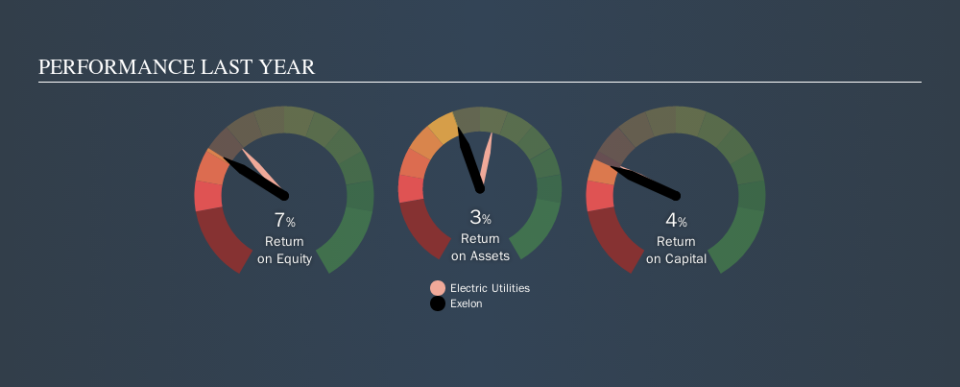Is Exelon Corporation’s (NASDAQ:EXC) 4.1% Return On Capital Employed Good News?

Today we'll look at Exelon Corporation (NASDAQ:EXC) and reflect on its potential as an investment. Specifically, we'll consider its Return On Capital Employed (ROCE), since that will give us an insight into how efficiently the business can generate profits from the capital it requires.
First of all, we'll work out how to calculate ROCE. Next, we'll compare it to others in its industry. Finally, we'll look at how its current liabilities affect its ROCE.
Understanding Return On Capital Employed (ROCE)
ROCE measures the 'return' (pre-tax profit) a company generates from capital employed in its business. In general, businesses with a higher ROCE are usually better quality. In brief, it is a useful tool, but it is not without drawbacks. Author Edwin Whiting says to be careful when comparing the ROCE of different businesses, since 'No two businesses are exactly alike.
So, How Do We Calculate ROCE?
The formula for calculating the return on capital employed is:
Return on Capital Employed = Earnings Before Interest and Tax (EBIT) ÷ (Total Assets - Current Liabilities)
Or for Exelon:
0.041 = US$4.5b ÷ (US$123b - US$13b) (Based on the trailing twelve months to September 2019.)
Therefore, Exelon has an ROCE of 4.1%.
View our latest analysis for Exelon
Does Exelon Have A Good ROCE?
When making comparisons between similar businesses, investors may find ROCE useful. We can see Exelon's ROCE is around the 4.9% average reported by the Electric Utilities industry. Independently of how Exelon compares to its industry, its ROCE in absolute terms is low; especially compared to the ~2.7% available in government bonds. It is likely that there are more attractive prospects out there.
You can see in the image below how Exelon's ROCE compares to its industry. Click to see more on past growth.
When considering ROCE, bear in mind that it reflects the past and does not necessarily predict the future. ROCE can be deceptive for cyclical businesses, as returns can look incredible in boom times, and terribly low in downturns. ROCE is only a point-in-time measure. What happens in the future is pretty important for investors, so we have prepared a free report on analyst forecasts for Exelon.
How Exelon's Current Liabilities Impact Its ROCE
Current liabilities are short term bills and invoices that need to be paid in 12 months or less. Due to the way the ROCE equation works, having large bills due in the near term can make it look as though a company has less capital employed, and thus a higher ROCE than usual. To counteract this, we check if a company has high current liabilities, relative to its total assets.
Exelon has total liabilities of US$13b and total assets of US$123b. Therefore its current liabilities are equivalent to approximately 11% of its total assets. With a very reasonable level of current liabilities, so the impact on ROCE is fairly minimal.
The Bottom Line On Exelon's ROCE
That's not a bad thing, however Exelon has a weak ROCE and may not be an attractive investment. Of course, you might also be able to find a better stock than Exelon. So you may wish to see this free collection of other companies that have grown earnings strongly.
For those who like to find winning investments this free list of growing companies with recent insider purchasing, could be just the ticket.
We aim to bring you long-term focused research analysis driven by fundamental data. Note that our analysis may not factor in the latest price-sensitive company announcements or qualitative material.
If you spot an error that warrants correction, please contact the editor at editorial-team@simplywallst.com. This article by Simply Wall St is general in nature. It does not constitute a recommendation to buy or sell any stock, and does not take account of your objectives, or your financial situation. Simply Wall St has no position in the stocks mentioned. Thank you for reading.


